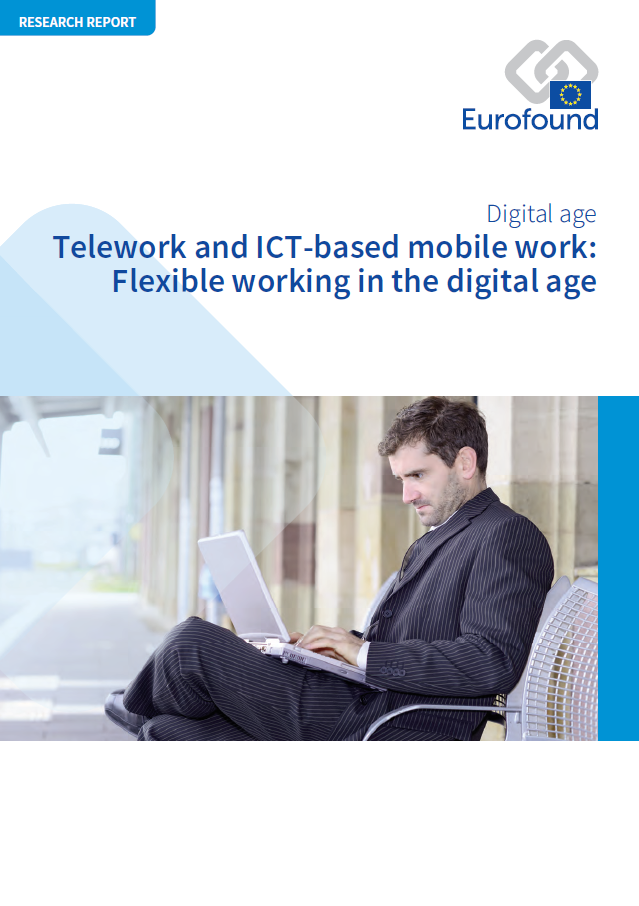
Advances in ICT have opened the door to new ways of organising work. We are shifting from a regular, bureaucratic and ‘factory-based’ working time pattern towards a more flexible model of work. Telework and ICT-based mobile work (TICTM) has emerged in this transition, giving workers and employers the ability to adapt the time and location of work to their needs. Despite the flexibility and higher level of worker autonomy inherent in TICTM, there are risks that this work arrangement leads to the deterioration of work–life balance, higher stress levels and failing worker health. This report analyses the employment and working conditions of workers with TICTM arrangements, focusing on how it affects their work–life balance, health, performance and job prospects. While policymakers in many EU countries are debating TICTM and its implications, the study finds that only a few have implemented new regulations to prevent TICTM from having a negative impact on the well-being of workers.
Key findings
Digitalisation and the advent of more flexible work organisation are changing working time patterns. Working time for workers who do telework and ICT-based mobile work (TICTM) is more porous, irregular and unpredictable.
TICTM can have clear benefits for people’s work–life balance, enabling them to adapt their working time to their private and family-related needs. However, these types of work arrangement can also lead to an intensification of work, even where workers have high levels of autonomy – a situation known as the autonomy paradox.
TICTM and other work environments characterised by high ICT use can pose health risks for workers: stress, anxiety, headaches and eye-strain are downsides linked these environments.
Virtual presenteeism is an increasing phenomenon in the digitalised work context and specifically among TICTM workers. While it might benefit workers by enabling them to carry out tasks while sick, it can also jeopardise their health and reduce performance.
Contrary to common perception, not all workers with a TICTM arrangement are high-flyers with better-than-average working conditions. Around one in four are in jobs with precarious conditions, including lack of access to training, low wages and job insecurity.
Tables
- Table 1: Work arrangements compared in the report
Graphs
- Figure 1: Shares of workers by type of work arrangement, EU28, 2015
- Figure 2: Shares of workers (employees and self-employed) with a TICTM arrangement (%), Member States, 2015
- Figure 3: Prevalence of types of work arrangement, by sector, EU28, 2015
- Figure 4: Shares of workers with a TICTM arrangement, by sector and occupation (%), EU28, 2015
- Figure 5: Shares of workers, by TICTM type, gender and age, EU28, 2015
- Figure 6: Factors influencing the impact of TICTM on work–life balance
- Figure 7: Correlation between flexible working time and TICTM, Member States, 2015
- Figure 8: Scores on autonomy index, by work arrangement, EU28 and five Member States, 2015
- Figure 9: Shares of workers who rarely or never have enough time to do their job (%), by work arrangement, EU28, 2015
- Figure 10: Scores on work intensity index, by work arrangement, EU28 and five Member States, 2015
- Figure 11: Shares of workers reporting working more than 48 hours per week (%), by work arrangement, EU28, 2015
- Figure 12: Shares of workers reporting a reduced rest period (%), by work arrangement, EU28, 2015
- Figure 13: Scores on working time quality index, by work arrangement, EU28 and five Member States, 2015
- Figure 14: Shares of workers reporting work–home interference (%), by work arrangement, EU28, 2015
- Figure 15: Shares of workers reporting work–life balance problems (%), by work arrangement and presence or absence of children, EU28, 2015
- Figure 16: Conceptual model for exploring the relationship between health and ICT use at work
- Figure 17: Association of job demands and job resources with health outcomes
- Figure 18: Effect of ICT use at work on health outcomes
- Figure 19: Shares of workers reporting headaches and eyestrain (%), by frequency of ICT use, EU28, 2015
- Figure 20: Shares of workers reporting stress, anxiety and fatigue by frequency of ICT use (%), EU28, 2015
- Figure 21: Shares of workers reporting presenteeism, by frequency of ICT use (%), EU28, 2015
- Figure 22: Effect of TICTM on health outcomes
- Figure 23: Association of types of work arrangements and health outcomes
- Figure 24: Shares of workers reporting fatigue, headaches and eyestrain, and anxiety (%), by work arrangement, EU28, 2015
- Figure 25: Shares of workers reporting presenteeism (%), by work arrangement, EU28, 2015
- Figure 26: Monthly average earnings in euro, by work arrangement, EU28, 2015
- Figure 27: Shares of workers who received employer-paid training (%), by work arrangement, EU28, 2015
- Figure 28: Shares of workers who participated in on-the-job training, by work arrangement (%), EU28, 2015
- Figure 29: Shares of workers who report that their job offers good prospects for career advancement (%), by work arrangement, EU28, 2015
- Figure 30: Highest level of regulation linking TICTM and work–life balance, by Member State
- Figure 31: Approximate coverage of regulations that include TICTM linked to work–life balance, Member States
- Figure 32: Presence and nature of legislation linking TICTM and work–life balance, Member States
- Number of pages
-
66
- Reference nº
-
EF19032
- ISBN
-
978-92-897-2043-4
- Catalogue nº
-
TJ-04-20-008-EN-N
- DOI
-
10.2806/337167
- Permalink
Cite this publication
Eurofound (2020), Telework and ICT-based mobile work: Flexible working in the digital age, New forms of employment series, Publications Office of the European Union, Luxembourg.
